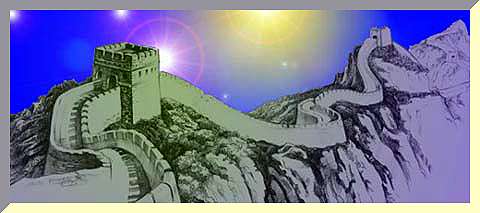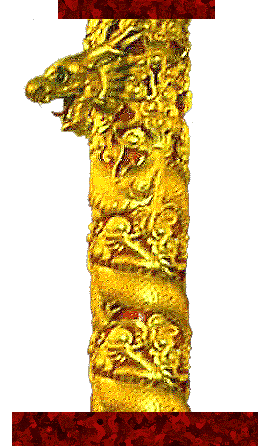| |
"Fear not the tigers of the South, but the roosters of the North."
These words of an ancient Chinese proverb warned Ch'in Shih Huang-ti in a dream.
When he awoke, the first emperor to unify China cast worried eyes toward the broad, exposed frontier. A series of watchtowers and short ramparts, vulnerable and alone, were all that stood guard against the northern nomads who crowed for power over the fabulous kingdom of the South.
Emperor Huang-ti called in his best engineers and told them of the dream. They devised a plan: link the existing bulwarks with battlements of stone; form an unbroken barrier; shut the barbarians out.
Thus did the Great Wall of China begin its serpentine crawl across North Asia, pressing westward through loess plains, broad deserts and rugged mountain chains. In keeping with the Chinese love for poetic exaggeration, its trailing ramparts soon became known as Wan-li-ch'ang Ch'en, "the Wall of 10,000 Miles."
Begun by Huang-ti in the 3rd century B.C. and completed 40 years later by Liu Pang, first of the Han emperors, the Wall actually covered a distance of 1,250 miles, as the crow flies. But three huge festoons--in the plains, in the desert and in the mountains--added 250 miles more, summing up to a total of 1,500 miles of structure, from which is derived one of its most literal names, the Long Wall.
By the majority of people today, Ch'in Shih Huang-ti ("Qin Shi Huangdi," in Pinyin spelling) is remembered more as the emperor whose tomb at Sian ("Xian," in Pinyin) in North China has become one of the most important archaeological digging sites in the 20th century. Thus far, a vast funerary complex has revealed a terra-cotta army of 7,500 life-size clay soldiers, many with horses, which were buried with the emperor 22 centuries ago.
The Beijing government has dispatched specimens of this stunning sculptural accomplishment for exhibition around the world. Already in its second generation of archaeologists, the site is yielding a wealth of information about the technological progress of ancient China. The project is expected to continue well into the 21st century.
It was another kind of "army," however, that made Huang-ti equally memorable in his own time.
While cunning tribesmen in the northern hills pondered ways to breach the Great Blockade, the Chinese people toiled. Purportedly, one out of every three able-bodied men in the Empire slaved on the Wall--a labor force perhaps exceeding a million people. Common criminals, foot soldiers and prisoners of war were among those drafted into service.
All persons found guilty of reading even the Confucian classics suffered exile to the work gangs on the Wall. For scholars unused to hard labor, that constituted a sentence of death. Tiger-like overseers killed those who stumbled from exhaustion, and then interred them where they fell.
Burial ground of tens of thousands who died in this manner, or in construction accidents along the route, the Wall earned the most sinister of its many names--the "Longest Cemetery on Earth."
But the luckless spirits thus entombed so enhanced its mystique that adepts in China's ancient, and still practiced, art of herbal medicine blended rare herbs, pulverized mouse, and powdered stone from the Great Wall to produce a curative which remained popular for centuries.
Legends sprang from the belief that the Wall was not a mundane, but a celestial, creation: Huang-ti, on a winged horse, marked out the course it followed, wielding a heavenly whip to slice away mountains hindering its path; prayer brought dreams revealing mysterious treasure in its depths, and evil spirits dared not cross it for fear of offending God.

Scores of unhappy lovers joined hands to leap into paradise from its "heaven-high" watchtowers. Fifteen thousand such towers, 40 to 50 feet in height, punctuated the Wall along its entire length. The connecting spans rose nearly 30 feet. A roadway, 20 feet wide and paved with hard-tamped loam, ran between clay-brick parapets crowning perpendicular sides made of granite masonry blocks.
How could so unethereal a formation have been considered divine? The Chinese were, and are, an incomparably intelligent race. In the shelter of the Great Wall, they perfected the magnetic compass, developed the abacus, created gunpowder and introduced printing. Their poets sing to us across the barrier of time. Their ancient philosophers strike chords of truth in hearts today.
Was this inventive, exquisitely cultivated society misguided in according empyrean status to the Great Wall of Stone?
Not in the broadest sense, for it was thought that the Wall conjoined humanity and the firmament in an extraordinary way; of all the man-made wonders of the world, it was believed to be the only one which could be seen from the moon or, according to some, from as far away as Mars. This belief, accepted as fact for centuries, persists despite contemporary evidence to the contrary. Photographs derived from the Landsat satellite rocketed into orbit on July 23, 1972, reveal that magnification and close scrutiny are required for viewing the Great Wall from a distance of only 600 miles above the surface of Earth.
Still, it is the architectural masterwork of man.
Physical magnificence notwithstanding, the Great Wall has ever proved to be of limited utility for defense. Barbarians overran it and ruled China in the 5th and 6th centuries A.D. Refortified in the 7th century by the victorious Sui Dynasty, again it gave way--this time, to the Mongols of Kublai Khan--in the 13th century. It underwent further reconstruction in the 15th and 16th centuries under the aegis of the Mings, who, in their turn, fled the throne before the northern Manchu a hundred years later.
Of the Great Wall, a waggish writer has observed: "The Chinese never got over it. But the Tartars did."
That facetious remark rings with truth, for infinitely less penetrable is the psychological wall which still barricades Chinese culture wherever it may be found.
Where the western end of the Wall surmounts a precipice near the borders of far-off Tibet, a tablet is inscribed: "The Martial Barrier of All Under Heaven." Perhaps that inscription best implies the Wall's most significant triumph--not peerless human engineering, but its metaphysical symbolism of the eternal Chinese distrust and exclusion of the outside world, a characteristic ably demonstrated by Mao Zedong's Communist government in the mid-20th century.
San Francisco's Chinatown, the largest Chinese community in the Western world, offers a case in point.
A "Great Wall" of silence exists to thwart the investigative efforts of police seeking to solve criminal cases traceable to Chinatown origins.
"Saving face" figures prominently among the factors buttressing the wall; Chinese people like to give a favorable impression of their race, a few even to the extent of reporting a Chinese perpetrator of a crime as being of a race other than Chinese.
Another is fear of vengeance if the criminal is identified; the Chinese inclination toward retaliation is a facet of the culture which must be recognized.
A third factor is the tangled web of criminal behavior which often binds one misdeed to another; a crime goes unrecorded because reporting it may require lifting the corner of a rug beneath which one's own criminalities have been swept safely out of sight.
For these reasons, and for yet another one, silence often is accepted as the best recourse.
The wall of silence is, indeed, a "martial barrier of all under heaven." Huang-ti's maxim, "Fear not the tigers of the South, but the roosters of the north," does not account for the fact that Chinatown's wall looms on all sides. It is ubiquitous.
It is often successful in its guardianship against the frustrated, blue-uniformed "roosters of the North," who batter against the outside, and whom the Chinese community looks upon as Tartars--by definition, "irritable, violent, intractable persons." But, like the true Tartars of North and Central Asia, the cops, too, sometimes get over the wall.
Unfortunately, the wall of silence furnishes perverse shelter for those who live on the other side. In accordance with the terms of Huang-ti's adage, thousands of defenseless people must today co-exist with fierce "tigers from the South." For such innocents, the proverb's admonition to "fear not" has a hollow ring.
Why Chinatown sustains its Great Wall of silence within traditionally tolerant San Francisco can be understood only by means of the fourth, all-important factor supporting it: the historic exclusion and persecution of the Chinese by white Americans.
|
|










